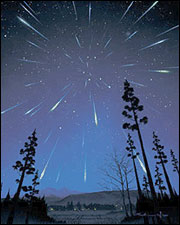The Perseids Are Falling!

In 2016, search the skies on August 11–12 for the Perseid meteor showers
 The Perseid meteor showers reach their peak on Aug. 11, 2016. Related Links |
A meteor shower is an increase in the number of meteors observed in a particular part of the sky. Meteor showers usually occur annually and with varying intensity.
The meteors of a meteor shower all appear to originate at a single point in the sky known as the radiant point, or radiant. A shower is named for the constellation in which its radiant is located, e.g., the Lyrids appear to come from a point in Lyra, the Perseids from Perseus, and the Orionids from Orion.
While the average counting rate of meteors for the entire sky is between 5 and 10 per hour, an observer may see twice this number in one part of the sky during a shower, and in the case of the Perseids, possibly more than 100 in an hour.
Head for the country
In the wee hours between Aug. 11 and 13 the meteor rate might exceed one or two per minute. If you're lucky (and patient) you may get to see an "earthgrazer," a meteor that skims the atmosphere in a long slow streak of color.
The best place to look for meteors is, obviously, somewhere dark, so being in or near an urban center is not ideal. Though some meteors can be seen from the city, the dimmer ones would be invisible. A field in the country, with a clear view of the northeast horizon, is a good choice. And you can leave your binoculars at home: viewing is best with the naked eye.
You should also be able to see Mars, visible as a bright red star under Perseus.
Meteors and Comets
Meteor showers are closely associated with comets. When a comet breaks up, a swarm of particles eventually becomes scattered out over its entire orbit. If this orbit intersects that of the earth, a meteor shower will be observed. The shower will be particularly intense in those years when the original comet would have been observed.
The source of the Perseids is Comet Swift-Tuttle. The tail of this comet intersects Earth's orbit every August, and the disintegrating particles of comet dust, most no bigger than sand grains, appear to us as streaks of light when they hit the atmosphere. The connection between the Perseids and Swift-Tuttle was made in the 1860s by Italian astronomer G.V. Schiaparelli, and marked the first time a meteor shower had been positively identified with a comet.
Significant showers
The Andromedids are associated with Biela's comet, and the Aquarids and Orionids are thought to be associated with Halley's comet. Some of the better-known meteor showers and their approximate dates are: Lyrids, Apr. 21; Perseids, Aug. 11; Orionids, Oct. 21; Leonids, Nov. 16; Geminids, Dec. 13.
The Columbia Electronic Encyclopedia, 6th ed. Copyright © 2005, Columbia University Press. All rights reserved.







